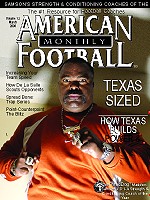AMERICAN FOOTBALL MONTHLY THE #1 RESOURCE FOR FOOTBALL COACHES
Article CategoriesAFM Magazine
|
Texas Sized StrengthHow Jeff Madden Builds Strength and Speed at Texasby: Matt Fulks © More from this issue Speed kills. Just ask most of the Texas Longhorns’ opponents during the 2005-06 season. That can be attributed largely to the players that head coach Mack Brown and his staff recruit. As big of a factor in the team’s success, however, is the strength and conditioning program the Longhorn players endure. Sure, endure. “Oh, I’ve been known as a guy that works them and works them hard,” laughed Jeff Madden, the University of Texas assistant athletics director for strength and conditioning. “We’re not going to lower our standards to a guy who doesn’t want to work. We’re trying to establish a work ethic here.” Since arriving at Texas with Brown in 1998, Madden, who’s known as “Maddog” by the chain around his neck, has helped turn the Longhorns into this....The full article can only be seen by subscribers. Subscribe today!
|
|
|||||||
| HOME |
MAGAZINE |
SUBSCRIBE | ONLINE COLUMNISTS | COACHING VIDEOS |
Copyright 2026, AmericanFootballMonthly.com
All Rights Reserved





